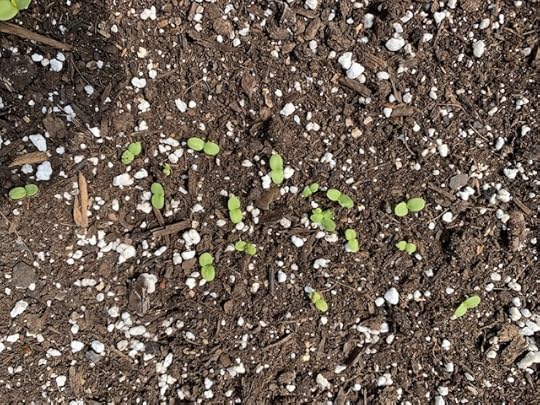Little Green Dots
BY STEVE BATES
I admit it. They don’t look like much.
Emerging seedlings. Just tiny green dots. They could be weeds, or my imagination. But to a gardener, the first plants to show up in the spring are a gift from heaven.
It will be more than a month before I can harvest and eat even the smallest plants, which will be lettuce and spinach seedlings thinned out because they are too close together. Or spring onions or radishes, which can mature in barely a month. It will be a meager result compared with those bright July days when I am swimming in tomatoes and blackberries.
But this time of year is magic.

One day, there is no plant. The next day, there is. Maybe it wasn’t even there an hour ago. Or maybe it was so small–and its color and shape blended into the soil so well–that I didn’t notice it then. I merely tossed a seed in the dirt, covered it, watered it, and waited. Not much of an investment on my part. Yet it’s on its way. It’s a miracle.
How can a dried speck that’s been sitting around in a paper packet for months or years produce a lettuce plant, or a pepper, or a zinnia? Wikipedia defines a seed as “an embryonic plant enclosed in a protective outer covering” and “the product of the ripened ovule, after fertilization by pollen and some growth within the mother plant”. (Sorry for any language that might be considered offensive. Memo to the New Right: You have already banned me, so don’t get excited.)
The seed bides its time with infinite patience, then starts to work as soon as conditions are right. Moisture, temperature, sometimes exposure to light. And maybe even a little encouragement. I still talk to my seeds and plants. Sometimes they don’t listen. Sometimes they even talk back. But it seems to be working.
Growing a garden is almost a religious experience for me. I grew up with parents of different religions who didn’t celebrate major holidays in more than a cursory fashion. (Well, I enjoyed Halloween, and they liked New Year’s Eve a lot.) Maybe I like growing things because I can’t bear a child myself, or because I’m in touch with my feminine side. (Again, apologies to the Culture Warriors on the right.)
Maybe, in part, it’s the challenge. Planting something the first week of March and expecting it to reach maturity can be frustrating. Many years, a cold snap will kill an early planting. Or a snow or ice storm, or too much rain, or too little. Or birds or land-hugging critters will wreak havoc.
Maybe it’s because I like getting my hands dirty. Or because much of the food in the grocery store is lousy. Or because I like to show off when I share my vegetable harvest or display my flowers. Or because the annual ritual is embedded in my soul.
I have analyzed my joy of gardening frequently over the years. It doesn’t matter why I love it. I am neither embarrassed nor apologetic for my favorite hobby. It simply is. And it simply is good.
If you can’t plant—or have no interest in—a spring garden, you can still take a moment to appreciate the daffodils and tulips, the flowering trees and shrubs, the longer days, the milder nights. Spring never seems to last long enough, like so many of the good things in life.



